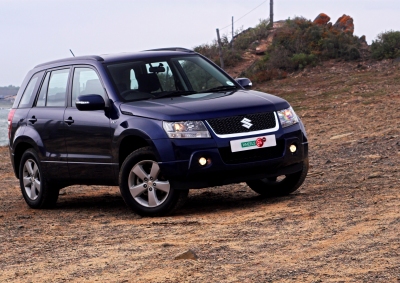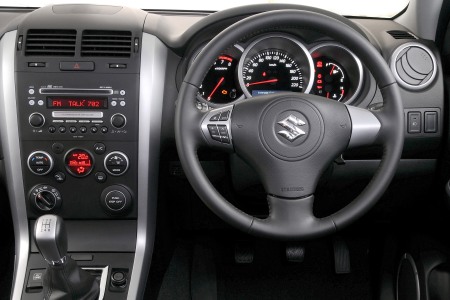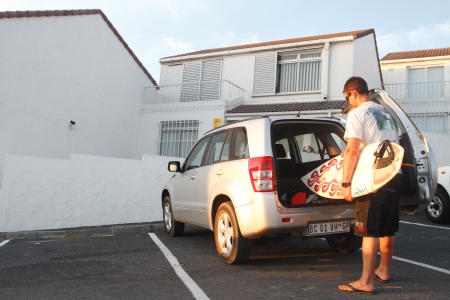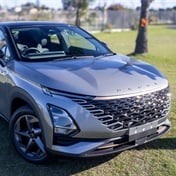
Suzuki never managed to market the Grand Vitara beyond a market profile of rugged adventurers though - and as a result it took Toyota’s RAV4 to popularise the compact SUV as an urban mobility fashion trend.
In the two decades since Suzuki launched its original Vitara the compact SUV market has become severely competitive.
There is now a range of outstanding products (especially of German and, lately, Korean origin) on offer. Off-road ability has been supplanted by interior comfort and convenience items and stylish design is a crucial factor in the purchasing rationale of most contemporary compact SUV buyers. This is a very different set of customer requirements to the buyer profile Suzuki originally identified when launching the Vitara range.
With this background, then, what is one to make of Suzuki’s Grand Vitara? Is the original compact SUV completely out of touch with modern market realities or does Suzuki’s headline range of vehicles represent a rather unique product offering for local buyers?
SENSIBLE OPTION
Suzuki retails three Grand Vitara derivatives locally, split across two engine options – a 2.4-litre four-cylinder and 3.2-litre V6. Unfortunately, even after thinly veiled promises at the launch three years ago, turbodiesel power has still not been made available for local buyers.
Our test vehicle was Suzuki’s cheapest Grand Vitara, its 2.4-litre petrol in five-speed manual transmission configuration.
Considering the 3.2-litre V6’s supercar thirst and the 2.4-litre four-speed automatic derivative’s rather antiquated shift regime, I’d say the baseline 2.4-litre five-speeder is the most sensible option.
As mentioned, in the compact SUV market styling is a crucial factor, aesthetics often being the make-or-break feature for potential buyers. Owners average an urban usage rate of around 90% for compact SUVs, which means you hardly want to be seen driving something of less than impressive aesthetic appeal around town. To this end Grand Vitara, despite its age (it was launched internationally back in 2006) remains a handsome vehicle.
Proportions and surfacing are both simple and clean; the relatively short overhangs (a design directive to improve approach and departure angles off-road) ensure neat proportions and an absence of messy detailing, especially overdone head or tail light designs (usually the bane of Japanese compact SUV design) help it cut a clean profile from all angles.
German compact SUV owners will disparagingly ask if Suzuki’s designers had any French-curve drawing sets at their disposal (considering the lack of curved surfaces and details), yet I think Grand Vitara is perhaps the best-looking of all current Japanese compact SUVs. Its simple linework, compact proportions and defined edges render a vehicle which appears to be an American SUV built to European size specifications – a compromise that makes it a perfect median aesthetic for the South African market.

SUZUKI SIMPLICITY: The Grand Vitara’s recessed instrument binnacle is clean and neat but the driving position a touch too high, infotainment system a touch of out step with current digital convergence trends…
The cabin has Suzuki’s familiar three-spoked, multifunction steering wheel fronting an instrument binnacle comprised of three neatly recessed dials.
Equipment levels are generous. Even our entry-level 2.4 manual featured keyless start, tinted windows, auto aircon, a six-disc CD shuttle infotainment system (MP3 compatible) and leather-trimmed steering wheel.
Safety’s well catered for with six airbags in place.
Two 12v sockets are positioned next to the transmission (to power a GPS or any external illumination devices you’ll need at night in the bush), and a large bin between the front seats accommodates any miscellaneous goodies.
As a whole the cabin design is a touch underwhelming, but at least it is not a typically horrid blend of fake Japanese teak and orange-hued backlighting. Perceived build-quality is outstanding with impeccably flush panel joints throughout.
There are two debit points with regards to Grand Vitara’s interior, though.
The first issue is ergonomic; the driver’s seat simply does not adjust to a setting low enough for tall drivers to position themselves behind the steering wheel with a perfect shoulder-elbow-wrist alignment for fatigue-free, long-distance driving.
Issue two relates to the infotainment system’s lack of either an auxiliary input or USB port. It is all fine and well providing a six-disc CD shuttle yet this is 2011 and most music is digital, stored on a device of some sort – which makes the half-dozen CD swallowing ability slight overkill when there is no way of connecting your iPod or external hard drive.

TAILGATE TERROR: Parked on a slight left-leaning slope, the taildoor keeps wanting to close in on you…
The Vitara’s capacious boot rates at 398 litres, fair for the class but peculiarly also the Suzuki’s weakest design feature.
Although Suzuki should be commended for the including a full-sized spare wheel – something European manufacturers inexplicably believe local SUV owners can do without – the Vitara’s full-sized spare is mounted on the rear door, which makes loading and unloading items impossible in some situations.
If you are parked on an incline, or a left-leaning slope, it takes a Herculean effort to shut (or keep open) the single-piece, sway-operated door, which inexplicably does not have a lock-out strut – plainly an unforgivable design oversight.
I was so overwhelmed with frustration one particular Saturday morning while trying to load my mountain bike that I summarily pushed my two-wheeler over to a flat part of the parking lot (some distance away from the race’s start/finish point), then drove the Grand Vitara over, before I could load my bike without the risk of being kneecapped by the return position momentum of that rear door.
If you wish to stop on a picturesque off-road trail (that happens to meander at a left-slope gradient) to admire the view and enjoy lunch, heed my advice: don’t bother. It will simply be an exercise of otherworldly annoyance to get those cooler boxes and fold-up chairs out the back.
Another issue is the wide arc of motion the tailgate moves through from left-to-right. It means you’re at the mercy of other drivers when trying to find the space to open up Grand Vitara’s loadbay to embark items when stopping at your local convenience store in a parallel parking bay.
OLD SCHOOL CHASSIS, NEW SCHOOL TRIM
Technically, Grand Vitara draws on Suzuki's diffuse heritage as a company that dabbles in an array of mechanical engineering transport solutions - automotive, motorcycle and marine.
Unlike most other SUVs, the Grand Vitara’s chassis is unique combination of ladder frame and monocoque. This design provides the ruggedness of a ladder frame without the packaging maladies or body-on-frame steering vagueness and body roll issues when cornering at speed – characteristics of ladder frame vehicles such as double cab bakkies.
As a driving experience the Grand Vitara is pleasingly refined. The steering retains much of that hydraulically assisted feel that is all but gone on most contemporary electrically assisted power steering systems, despite being electrically powered. Placing Grand Vitara easily on the road is effortless, affecting safe directional changes at speed, with absolutely no trace of waywardness despite the knowledge that you are riding atop a hybrid ladder frame/monocoque chassis.
The all-found independent suspension features outstandingly compromised damper calibration too. Individual wheel bound and rebound never feels out of step, ensuring predictably manageable feedback and responses through the helm - no matter what surface you are traversing.
Aside from the impressive ride/handling balance, how does Grand Vitara’s naturally aspirated 2.4-litre engine cope? Admittedly, it is not the most technologically advanced unit. Power peaks at 122kW, supported by 225Nm of torque; with drive apportioned between all four wheels via a five-speed manual transmission featuring, as with all other Suzuki products, a most delightfully solid mechanical shift action through the h-gate.
With performance statistics of 0-100km/h in 11.7 seconds and a top speed of 180km/h, Grand Vitara is not as quick as its forced-induction compact SUV competitors. At Gauteng altitudes turbodiesel rivals are appreciably swifter and in all probability more frugal too. Fuel consumption during our test period averaged to 11.7l/100km, compared to a claimed 8.9l/100km.
Gauged as a day-to-day driving machine I found Grand Vitara to be a touch weak at low crankspeeds in certain urban driving scenarios (powering onto straights after roundabouts), yet once up to highway cruising speeds the engine’s output and transmission’s gearing seem to find each other. A quick (always satisfying) shift down to fourth-gear never found me in doubt when attempting to pass slower trucking traffic.

UPWARDLY MOBILE: Whereas other compact SUVs shy away from challenging terrain, the Grand Vitara’s low-range capability welcomes it…
Where the Vitara really comes into its own is during a sojourn off-road.
Whereas most rival compact SUVs employ clutch-packs and ABS modulated traction control technologies to mimic a level of pseudo off-road ability, Grand Vitara sports a proper reduction ratio transfer case.
Although it does not have the ultimate in traction security at the rear axle (there is no locker), you can run it with proper crawler gear ability in low range. This means maximum torque at low (read: controllable) speeds, yielding manageable throttle responses for slow, safe progress over obstacles its 200mm’s of ground clearance can manage.
Further aiding its off-road ability, especially in sand, are Grand Vitara’s 225/65 profile Bridgestone Dueller H/Ts rolling on 17-inch wheels.
Admittedly 16-inch wheels would have been the ultimate for real Safari specification exploring, these 225/65’s still manage to retain enough sidewall to ensure proper deflation properties (elongating the tread’s contact surface), thereby boosting traction in sand driving conditions.
Suffice to say, with the Grand Vitara 2.4 in low range, you’ll finish your day’s off-roading without that distinct smell of a rather hot clutch permeating the cabin – a scent that cruelly signals the cost of progress when a non-low range enabled SUV attempts to do some mildly challenging off-roading.
IT CAN ACTUALLY GO OFF-ROAD
Suzuki’s Grand Vitara is hardly a new design, with the current model having been on sale internationally since 2006. Its sleek (simple) styling, quality build throughout and reassuring mechanical feel make Grand Vitara a vehicle to suit those who demand a certain level of robustness from their compact SUV.
I’ll be honest: the loadbay is a bit of a design disaster, with the tailgate being practically inoperable when parked at certain angles. That said, this is the only real issue I could find with the Grand Vitara.
The only other SUVs in class offering proper low-range ability are Subaru’s Forester and Jeep Cherokee, of which the latter is hardly competition as its cabin design and ergonomics are simply intolerable.
Subaru’s low-range enabled baseline Forester is nearly R30 000 cheaper than the Suzuki though – and probably, oddly – its most capable competitor. Not that any of this would matter to most fashion obsessed compact SUV buyers, who are happily content with the ability of their Tiguan, Xtrail or ix35 to ramp up a mall parking lot’s kerbing when required.
For those who require value off-roading capability combined with seamless urban commuting, there are alternatives – such as Suzuki’s Grand Vitara…




 Publications
Publications
 Partners
Partners














